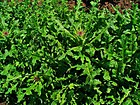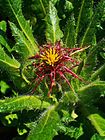Note: This is a project under development. The articles on this wiki are just being initiated and broadly incomplete. You can Help creating new pages.
Difference between revisions of "Cnicus benedictus - Cnicus"
Chaithrika (talk | contribs) (+Common names) |
(→References) |
||
| (20 intermediate revisions by 2 users not shown) | |||
| Line 1: | Line 1: | ||
[[File:Cnicus benedictus flor.jpg|thumb|right|''Cnicus benedictus'', ''spotted thistle'']] | [[File:Cnicus benedictus flor.jpg|thumb|right|''Cnicus benedictus'', ''spotted thistle'']] | ||
| + | '''Cnicus benedictus''' is a thistle-like plant in the family Asteraceae. It is native to the Mediterranean region, from Portugal north to southern France and east to Iran. It is known in other parts of the world, including parts of North America, as an introduced species and often a noxious weed. | ||
| + | ==Uses== | ||
| + | {{Uses|Cold}}, {{Uses|Flu}}, {{Uses|Depression}}, {{Uses|Menstrual cramps}}, {{Uses|Menopause}}, {{Uses|Diarrhea}}. | ||
| − | + | ==Parts Used== | |
| + | {{Parts Used|Flowers}}, {{Parts Used|Leaves}}. | ||
| − | == | + | ==Chemical Composition== |
| + | Blessed thistle contains lignans, essential oil, tannins and the minerals calcium, potassium, iron, magnesium and manganese. The main bitter substance is cnicin present in a concentration of 0.2 to 0.7 percent<ref name="chemical composition"/> | ||
| − | + | ==Common names== | |
| + | {{Common names|kn=|ml=|sa=|ta=|te=|hi=|en=Agrimony}} | ||
| − | + | ==Properties== | |
| + | Reference: Dravya - Substance, Rasa - Taste, Guna - Qualities, Veerya - Potency, Vipaka - Post-digesion effect, Karma - Pharmacological activity, Prabhava - Therepeutics. | ||
| + | ===Dravya=== | ||
| − | == | + | ===Rasa=== |
| − | |||
| − | |||
| − | |||
| − | == | + | ===Guna=== |
| − | + | ===Veerya=== | |
| − | == | + | ===Vipaka=== |
| − | <references> | + | ===Karma=== |
| − | <ref name=" | + | |
| + | ===Prabhava=== | ||
| + | |||
| + | ==Habit== | ||
| + | {{Habit|Annual plant}} | ||
| + | |||
| + | ==Identification== | ||
| + | ===Leaf=== | ||
| + | {{Leaf|Simple||The leaves are divided into 3-6 toothed leaflets, with smaller leaflets in between}}<ref name="Leaf"/> | ||
| + | |||
| + | ===Flower=== | ||
| + | {{Flower|Unisexual|2-4cm long|Yellow|5-20|Flowers Season is June - August}} | ||
| + | |||
| + | ===Fruit=== | ||
| + | {{Fruit||7–10 mm (0.28–0.4 in.) long pome|Clearly grooved lengthwise, Lowest hooked hairs aligned towards crown|With hooked hairs|}} | ||
| + | |||
| + | ===Other features=== | ||
| + | |||
| + | ==List of Ayurvedic medicine in which the herb is used== | ||
| + | * [[Vishatinduka Taila]] as ''root juice extract'' | ||
| + | |||
| + | ==Where to get the saplings== | ||
| + | ==Mode of Propagation== | ||
| + | {{Propagation|Seeds}}. | ||
| + | |||
| + | ==How to plant/cultivate== | ||
| + | Sow Blessed Thistle seeds directly outdoors in the spring after danger of frost has passed<ref name="How to plant/cultivate"/> | ||
| + | |||
| + | ==Commonly seen growing in areas== | ||
| + | {{Commonly seen|Mediterranean countries}}, {{Commonly seen|Southeast Asia}}. | ||
| + | |||
| + | ==Photo Gallery== | ||
| + | <gallery class="left" caption="" widths="140px" heights="140px"> | ||
| + | File:Cnicus benedictus 001.JPG | ||
| + | File:Cnicus benedictus hojas.jpg|Leaf | ||
| + | File:Cnicus benedictus 002.JPG | ||
| + | File:Cnicusbenedictus.jpg|Seed | ||
| + | |||
| + | </gallery> | ||
| + | |||
| + | ==References== | ||
| + | |||
| + | <references> | ||
| + | <ref name="chemical composition">[https://www.herbal-supplement-resource.com/blessed-thistle-herb.html Chemical description]</ref> | ||
| + | |||
| + | <ref name="Leaf">[https://web.archive.org/web/20131226161459/http://www.wildflowers-guide.com/39-agrimony.html Flowers description]</ref> | ||
| + | |||
| + | <ref name="How to plant/cultivate">[https://www.outsidepride.com/seed/herb-seed/blessed-thistle.html Cultivation details]</ref> | ||
</references> | </references> | ||
| − | == External Links == | + | ==External Links== |
| − | |||
| − | |||
| + | * [https://www.sigmaaldrich.com/life-science/nutrition-research/learning-center/plant-profiler/cnicus-benedictus.html Synonyms / Common Names / Related Terms of Cnicus benedictus] | ||
| + | * [https://www.henriettes-herb.com/eclectic/kings/cnicus.html Cnicus benedictus on Henriette's Herbal Homepage] | ||
| + | * [https://www.avogel.ch/en/plant-encyclopaedia/cnicus_benedictus.php Plant Encyclopaedia > Cnicus benedictus L] | ||
| + | * [http://hermionesgarden.blogspot.in/2011/05/cnicus-benedictus-blessed-thistle.html Cnicus benedictus on Growing Hermione's Garden] | ||
| + | * [http://practicalplants.org/wiki/Cnicus_benedictus Cnicus benedictus on Practical Plants] | ||
[[Category:Herbs]] | [[Category:Herbs]] | ||
| + | [[Category:Asteraceae]] | ||
Latest revision as of 13:07, 17 April 2020
Cnicus benedictus is a thistle-like plant in the family Asteraceae. It is native to the Mediterranean region, from Portugal north to southern France and east to Iran. It is known in other parts of the world, including parts of North America, as an introduced species and often a noxious weed.
Contents
- 1 Uses
- 2 Parts Used
- 3 Chemical Composition
- 4 Common names
- 5 Properties
- 6 Habit
- 7 Identification
- 8 List of Ayurvedic medicine in which the herb is used
- 9 Where to get the saplings
- 10 Mode of Propagation
- 11 How to plant/cultivate
- 12 Commonly seen growing in areas
- 13 Photo Gallery
- 14 References
- 15 External Links
Uses
Cold, Flu, Depression, Menstrual cramps, Menopause, Diarrhea.
Parts Used
Chemical Composition
Blessed thistle contains lignans, essential oil, tannins and the minerals calcium, potassium, iron, magnesium and manganese. The main bitter substance is cnicin present in a concentration of 0.2 to 0.7 percent[1]
Common names
| Language | Common name |
|---|---|
| Kannada | |
| Hindi | |
| Malayalam | |
| Tamil | |
| Telugu | |
| Marathi | NA |
| Gujarathi | NA |
| Punjabi | NA |
| Kashmiri | NA |
| Sanskrit | |
| English | Agrimony |
Properties
Reference: Dravya - Substance, Rasa - Taste, Guna - Qualities, Veerya - Potency, Vipaka - Post-digesion effect, Karma - Pharmacological activity, Prabhava - Therepeutics.
Dravya
Rasa
Guna
Veerya
Vipaka
Karma
Prabhava
Habit
Identification
Leaf
| Kind | Shape | Feature |
|---|---|---|
| Simple | The leaves are divided into 3-6 toothed leaflets, with smaller leaflets in between |
Flower
| Type | Size | Color and composition | Stamen | More information |
|---|---|---|---|---|
| Unisexual | 2-4cm long | Yellow | 5-20 | Flowers Season is June - August |
Fruit
| Type | Size | Mass | Appearance | Seeds | More information |
|---|---|---|---|---|---|
| 7–10 mm (0.28–0.4 in.) long pome | Clearly grooved lengthwise, Lowest hooked hairs aligned towards crown | With hooked hairs | {{{6}}} |
Other features
List of Ayurvedic medicine in which the herb is used
- Vishatinduka Taila as root juice extract
Where to get the saplings
Mode of Propagation
How to plant/cultivate
Sow Blessed Thistle seeds directly outdoors in the spring after danger of frost has passed[3]
Commonly seen growing in areas
Mediterranean countries, Southeast Asia.
Photo Gallery
References
External Links
- Ayurvedic Herbs known to be helpful to treat Cold
- Ayurvedic Herbs known to be helpful to treat Flu
- Ayurvedic Herbs known to be helpful to treat Depression
- Ayurvedic Herbs known to be helpful to treat Menstrual cramps
- Ayurvedic Herbs known to be helpful to treat Menopause
- Ayurvedic Herbs known to be helpful to treat Diarrhea
- Herbs with Flowers used in medicine
- Herbs with Leaves used in medicine
- Herbs with common name in English
- Habit - Annual plant
- Index of Plants which can be propagated by Seeds
- Herbs that are commonly seen in the region of Mediterranean countries
- Herbs that are commonly seen in the region of Southeast Asia
- Herbs
- Asteraceae




